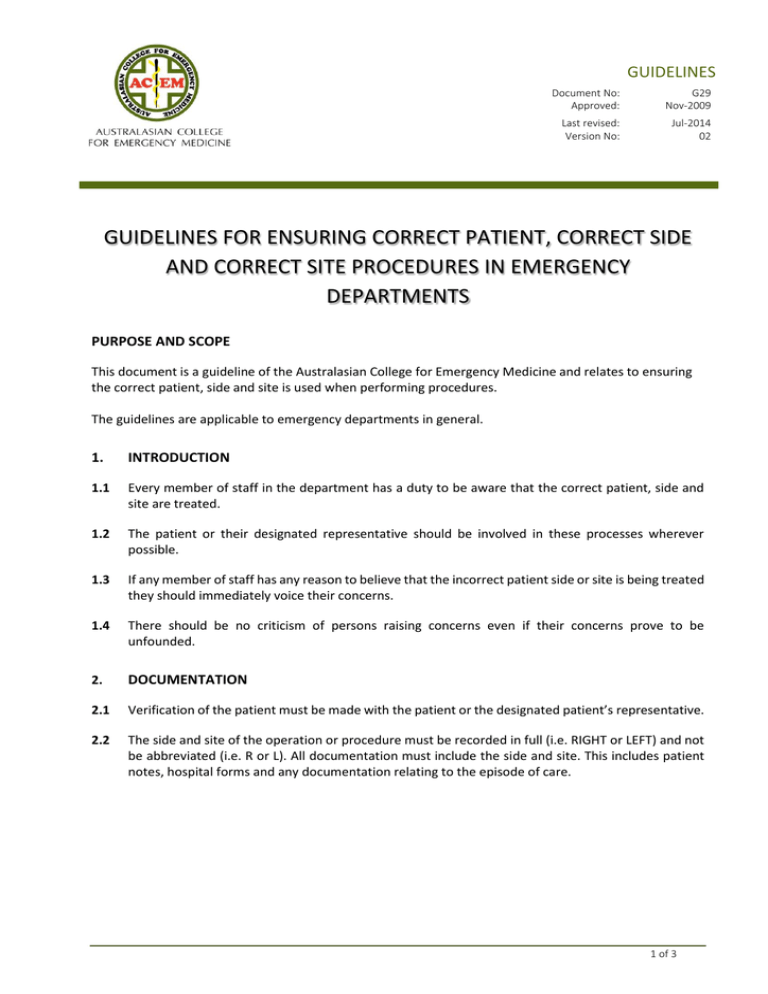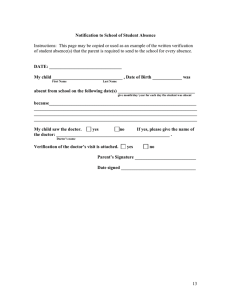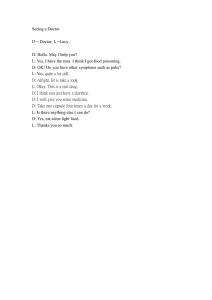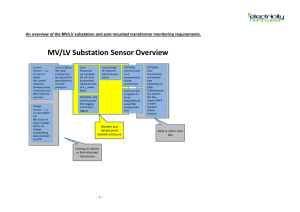
GUIDELINES
Document No:
Approved:
G29
Nov-2009
Last revised:
Version No:
Jul-2014
02
050505
GUIDELINES FOR ENSURING CORRECT PATIENT, CORRECT SIDE
AND CORRECT SITE PROCEDURES IN EMERGENCY
DEPARTMENTS
PURPOSE AND SCOPE
This document is a guideline of the Australasian College for Emergency Medicine and relates to ensuring
the correct patient, side and site is used when performing procedures.
The guidelines are applicable to emergency departments in general.
1.
INTRODUCTION
1.1
Every member of staff in the department has a duty to be aware that the correct patient, side and
site are treated.
1.2
The patient or their designated representative should be involved in these processes wherever
possible.
1.3
If any member of staff has any reason to believe that the incorrect patient side or site is being treated
they should immediately voice their concerns.
1.4
There should be no criticism of persons raising concerns even if their concerns prove to be
unfounded.
2.
DOCUMENTATION
2.1
Verification of the patient must be made with the patient or the designated patient’s representative.
2.2
The side and site of the operation or procedure must be recorded in full (i.e. RIGHT or LEFT) and not
be abbreviated (i.e. R or L). All documentation must include the side and site. This includes patient
notes, hospital forms and any documentation relating to the episode of care.
1 of 3
(Guidelines For Ensuring Correct Patient, Correct Side and Correct Site Procedures in Emergency Departments)
(G29)
3.
MARKING THE SITE OF THE PROCEDURE
3.1
The doctor should be satisfied on which side and site the procedure has to be performed. This must
occur in consultation with the patient or delegate.
3.2
An indelible pen is used to unambiguously mark the side and site of the procedure where not selfevident. This is done and confirmed by the doctor in consultation with the patient/delegate (where
possible) and recorded in the medical record. The side and site is confirmed by another person.
3.3
The doctor confirms the side and site prior to commencing the procedure to ensure that this is in
accordance with his or her intended procedure before any anaesthesia is commenced.
4.
IMAGING
4.1
The doctor and team must confer to ensure that the relevant images are available.
5.
FINAL VERIFICATION
5.1
The doctor and medical team must confer and concur to ensure the correct patient, procedure, side
and site where not self-evident. Marking of the site must be confirmed. A “time out” or “final check”
should be part of the procedure. This should preferably occur before any anaesthesia is commenced
6.
EMERGENCIES
6.1
In emergency (life or limb threatening situations) some of these steps may be omitted and provisions
must exist in each jurisdictional legislative framework to allow management to proceed without
formal consent.
7.
SUMMARY
7.1
At all stages of this process there should be consistency of documentation of the affected side and
site. If any inconsistency arises, the procedure should be suspended, the documentation should be
corrected, signed and an explanation of the inconsistency documented in the patient’s medical
record and signed by the doctor.
7.2
The doctor should satisfy him/herself of the appropriate side and site of the procedure and record
this in the patient’s medical notes before proceeding. Any incident should be recorded and logged
through the standard process.
2 of 3
(Guidelines For Ensuring Correct Patient, Correct Side and Correct Site Procedures in Emergency Departments)
(G29)
8.
REFERENCES
8.1
The Royal Australasian College of Surgeons. “Implementation Guidelines for Ensuring Correct Patient,
Correct Side and Correct Site Surgery”. October 2006.
9.
DOCUMENT REVIEW
Timeframe for review:
9.1
every five (5) years, or earlier if required.
Responsibilities
Document authorisation: Council of Advocacy, Practice and Partnerships
Document implementation: Council of Advocacy, Practice and Partnerships
Document maintenance:
Policy and Research Department
9.2
Revision History
Version
Date of
Version
Pages revised / Brief Explanation of Revision
v1
Nov-2009
Approved by Council
V2
Jul-2014
No changes made.
© Copyright – Australasian College for Emergency Medicine. All rights reserved.
3 of 3






